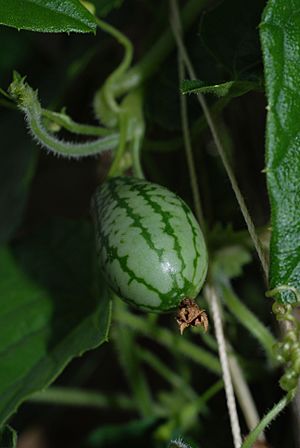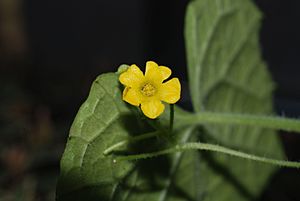Cucamelon facts for kids
Quick facts for kids Cucamelon |
|
|---|---|
 |
|
| Vine with fruit | |
| Scientific classification | |
| Genus: |
Melothria
|
| Species: |
scabra
|
| Synonyms | |
|
|
The cucamelon (scientific name: Melothria scabra) is a cool little plant. It is also known by fun names like Mexican miniature watermelon or mouse melon. This plant is part of the cucumber and squash family. People grow it for its yummy fruit.
Cucamelons are originally from places like Mexico all the way down to Venezuela. Their fruits are tiny, about the size of a grape. They taste like a cucumber but with a little sour kick. It is thought that native peoples in the Americas might have eaten them long ago.
Contents
What Does a Cucamelon Plant Look Like?
The cucamelon plant is a vine that loves to climb. It can grow quite tall, usually about 2.5 to 3 meters (8 to 10 feet) high. It grows very fast! Seeds can sprout in about 10 days. The plant is ready to produce fruit in about 60 to 75 days.
Cucamelons are perennial plants. This means they can live for more than two years. But they do not like cold weather or frost. So, in many places, people grow them as annuals, meaning they live for only one growing season.
Leaves and Flowers
The leaves of the cucamelon plant have three or five rounded parts. They are about 3 to 7 centimeters (1 to 3 inches) long and wide. The leaves feel a bit rough because they have tiny hairs on them.
Like some cucumbers, cucamelon plants have both male and female flowers on the same plant. The flowers are small and yellow, about 4 millimeters (0.15 inches) across. What is interesting is that the female flowers appear before the male ones. These plants can pollinate themselves, but each individual flower needs pollen from a different flower to make fruit.
The Fruit
Each cucamelon plant can grow hundreds of fruits! The fruits grow at the base of the female flowers. They are shaped like small olives, about 2.5 to 4 centimeters (1 to 1.5 inches) long. They are green with darker green stripes. Unlike some wild plants in the cucumber family, cucamelon fruits taste sweet, not bitter.
Cucamelon plants are also quite strong. They can handle dry weather well. They are also good at resisting pests compared to other cucumber plants.
Where Did the Name Come From?
Scientific Name
The scientific name for the cucamelon is Melothria scabra.
- The first part, Melothria, comes from an old Greek word. It means 'kind of white grape'. This name was chosen because the plant has small fruits, like tiny grapes.
- The second part, scabra, is a Latin word. It means 'rough' or 'scabby'. This describes the slightly rough feel of the plant's leaves.
Common Names
The popular English language name 'cucamelon' was first used in the 1980s. It is a mix of two words: 'cucumber' and 'melon'.
In Spanish, one common name is 'sandita'. This means 'little watermelon'. It comes from the Spanish word 'sandía' (watermelon) and the ending -ita, which means 'small'.
Where Do Cucamelons Grow?
Melothria scabra is native to several countries. These include Colombia, El Salvador, Guatemala, Honduras, Mexico, Nicaragua, Panama, and Venezuela. In these places, you can find them growing in forests and thick bushes.
Plant Problems
Like all plants, cucamelons can sometimes get sick. They can be affected by plant diseases like downy mildew and powdery mildew. These are caused by tiny plant germs. They can also get a sickness called cucumber mosaic virus.
Growing Cucamelons
People grow Melothria scabra as a small crop because of its fruits. The fruits are often eaten fresh, or they can be pickled like regular cucumbers.
See also
 In Spanish: Melothria scabra para niños
In Spanish: Melothria scabra para niños


